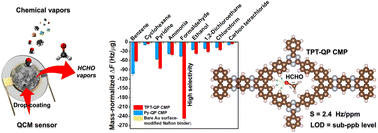A phenazine-conjugated microporous polymer-based quartz crystal microbalance for sensitive detection of formaldehyde vapors at room temperature: an experiment and density functional theory study†
Abstract
Conjugated microporous polymers (CMPs) are a prospective class of porous materials that are promising in a wide variety of applications due to their outstanding physical and chemical properties. Here, we introduce a strategy to synthesize two novel phenazine-based CMPs, namely, TPT-QP and Py-QP CMPs through the Suzuki coupling condensation reaction of 3,6,14,17-tetrabromodibenzo[a,c]dibenzo[5,6:7,8]quinoxalino[2,3-i]phenazine (QP-4Br) with boronic acid pinacol ester of triphenyltriazine (TPT-3Bpin) and pyrene (Py-4Bpin), respectively. These two CMPs are fully characterized and exhibit high surfaces areas, and good thermal stabilities. Interestingly, the obtained TPT-QP CMP has a considerable number of hydrogen-bonding sites, which are able to detect sub-ppm of vaporized acidic hydrocarbons with high sensitivity and selectivity. In this study, a phenazine-based CMP-based quartz crystal microbalance (QCM) sensor is fabricated for the first time, and it demonstrates an excellent capacity to detect trace amounts of volatile formaldehyde (HCHO). The density functional theory (DFT) calculations reveal that interaction between HCHO and the TPT-QP CMP is dominated by hydrogen-bonding interaction. The active sites of the TPT-QP CMP act as antennae for the selective detection of HCHO vapors over other interfering gaseous chemical-vapor analytes. The sensitivity of the TPT-QP-based QCM sensor towards HCHO is found to be among the highest (2.4 Hz ppm−1) of the substances examined, with a limit of detection (LOD) down to the sub-ppm level. On the other hand, the Py-QP CMP having lower content of hydrogen-bonding sites exhibited lower sensitivity towards HCHO, but more sensitive to benzene which could be attributed to the stronger π–π stacking interaction between the π-rich electron pyrene units and benzene. This sensing technique based on the TPT-QP CMP creates a simple, low-cost method for enhancing QCM sensors' functionality in detecting HCHO vapors with the use of smart electronic noses.



 Please wait while we load your content...
Please wait while we load your content...